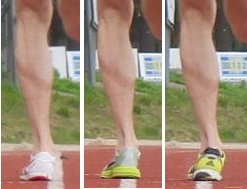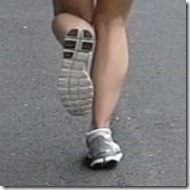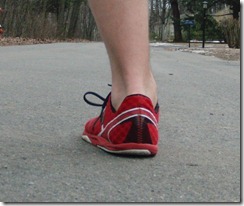 Two days ago I posted commentary on an article by podiatrist Ian Griffiths that discussed why the term “overpronation” is inaccurately applied and should be banished as a blanket criterion for assigning shoes to runners. I did quite a bit of research on this topic while writing my book, and my overwhelming conclusion was that pronation should not be given the primacy in the shoe fitting process that it is currently afforded.
Two days ago I posted commentary on an article by podiatrist Ian Griffiths that discussed why the term “overpronation” is inaccurately applied and should be banished as a blanket criterion for assigning shoes to runners. I did quite a bit of research on this topic while writing my book, and my overwhelming conclusion was that pronation should not be given the primacy in the shoe fitting process that it is currently afforded.
One study that made a big impact on my thinking was published as part of a conference proceedings back in 2003. Titled “Do Pronators Pronate?” and authored by Stefanyshyn et al. from the University of Calgary, the study examined whether runner’s beliefs about which pronation category they belong to actually matched with how much their feet everted when measured in a laboratory (note, eversion is one component of the complex movement we call pronation and can be though of simply as the inward roll of the foot after contact).
In the study, the authors examined a total of 83 runners (42 males, 41 females) who self-classified themselves as either a “pronator,” a “normal” runner, or a “supinator” (self classification most likely resulting from being told in a shoe shop or through observation of their arch height). Forty one subjects classified themselves as pronators, 40 classified themselves as normal, and 2 classified themselves as supinators.
The researchers attached markers to the legs and feet of the runners and had them run five trials barefoot and five in a neutral shoe. Runners were filmed in slow motion as they ran across a force platform – this allowed for a detailed quantification of foot eversion.
For the barefoot condition, they classified individuals with a change in eversion (i.e., inward foot roll) of >15 degrees as pronators. For the shod condition, the pronator category cutoff was a change in eversion of > 16.5 degrees.
Here’s where things get interesting. The results showed that for the 41 subjects who called themselves “pronators,” only 5 fell into the “pronator” category in both the shod and barefoot conditions (12%!), and nearly 70% did not exhibit high eversion in either the barefoot or shod conditions. In other words, 70% of the runners who considered themselves to be pronators were actually well within the normal range based on the criteria established by the researchers!
Similar to the above, “normal” pronators were also pretty lousy at their self-classification. Eighteen of the 40 self-classified “normal” runners exhibited a level of eversion that exceeded the “pronator” cutoff – that’s nearly 50% of normal runners who were actually pronators based on the classification criteria.
The authors suggest that runners may define their pronation category based upon observation of their arch height, but found no significant differences between loaded arch height in the self selected “pronator” vs. “normal” groupings (the only significant arch height difference was a lower unloaded arch in male pronators compared to normal males). They also found no correlation between arch height and amount of eversion, indicating that arch height is not a valid indicator of how much a runner pronates (so much for the wet test! – for more on arch height, read this post).
Based on these results, the authors concluded the following:
“The above results lead to the following conclusions: Barefoot eversion, shod eversion and the perception of pronation are variables that do not describe the same phenomenon. People who consider themselves to be pronators may not be pronators. People who consider themselves to be normal may be pronators.”
Does not instill confidence that we know ourselves as well as we think we do, does it!
So, just because somebody told you that you are an overpronator does not mean that you actually are, and just because you have flat feet does not mean that you necessarily pronate excessively (maybe you can skip the motion control…).
Even if you are an overpronator, unless it’s severe, it may not matter all that much. Dr. Benno Nigg, who was one of the co-authors of this study, states in his recent book, Biomechanics of Sports Shoes, that:
“Pronation and supination have long been the “danger variables” hanging over the sport shoe community, but their time as the most important aspects of sport shoe construction is over. Pronation is a natural movement of the foot, and “excessive pronation” is a very rare phenomenon. Shoe developers, shoe stores, and medical centres should not be too concerned about “pronation and supination.”
In his book Nigg also says that based on his extensive research into the topic, and his knowledge of the relevant literature: “overpronation, as it occurs in typical runners, is not a critical predisposition for injuries.”
(Incidentally, if you don’t know who Benno Nigg is, he’s a highly respected footwear expert and was one of the pioneers of the development of stability shoes in the early 1980’s. He has since changed his mind, and was quoted in Runner’s World saying the following: “I pushed the cushioning trend as much as anyone…And I take the blame for pronation devices as well.”)
The above information contributes to why I believe that the pronation control model of shoe fitting needs to disappear – pronation can still be considered on an individual level when problems arise, but it should not be a primary criterion by which shoes are suggested to people in a shoe shop.
Stay tuned, as I plan to follow up shortly with a summary of a more recent study that provides similar results.
To read the Stefanyshyn paper click here.
















The over pronation shenanigans are the works of ill educated, profit hungry shoe companies. We’ve adapted to running without shoes hundreds of thousands of years ago. I’m sure someone was born deformed and needs some sort of correction but for the vast majority of the population, it’s a gimmick.
So based on this, runners should move/start with a neutral shoe and go from there. I’m not sure what would then trigger the need for possible pronation support shoes. Would that be injury, soreness or some other aspect of running that says hey, maybe a support type shoe would be best.
No, the whole notion of neutral vs. stability is pretty much meaningless if you ask me. There are no standards for what makes one shoe neutral and another stability. If you look at the photo at the top of the post, all three are neutral shoes, but look at the difference in eversion between them. Neutral shoes can cave medially and cause problems for people. I think people just need to go to a shop where they can test a few shoes out on a short run and choose the one that feels best. It might be stability, it might be neutral, go by feel and comfort.
—-
Pete Larson’s Web Links:
My book: Tread Lightly – link to ow.ly
Blog: https://runblogger.com
Twitter: link to twitter.com
Facebook: link to facebook.com…
I’d love to see a 4th picture: the same runner without any shoes. I bet he would overpronate even less, if at all. The third picture is really telling of how shoes can create an artificial rolling in of the foot and lead to injury.
I have one, will find the link.
It’s in this post: link to runblogger.com…
If you have access to a treadmill with slow-mo video (gait analysis), which many do through their local running shops, I don’t think this study adds anything at all. Who cares about self assessment in three broad categories? And if you are not running barefoot, it doesn’t matter what your change in eversion is when you are running barefoot. If I had been in this study, I don’t know that I would have liked to have put myself into any category. I know from gait analysis that my degree of pronation/change in eversion is very different depending on the shoe, how I would place a shoe in a category based on what it does to my change in eversion in a gait analysis sometimes doesn’t fit what category shoe is labeled to be in (looking simply at rank order of degree of stability in a shoe). I haven’t tried barefoot on the store treadmill, though I’m assuming neutral, and if I’m wrong, it doesn’t matter. I don’t think someone can tell if they overpronate by feel – they need to see it in a photo or video of themselves while running, whether by a still photo (like your far right photo) or in a gait analysis. Based on that belief, I think people in the study probably self categorized based on what kind of shoe was working well for them prior to the study – and the study doesn’t show that they were wrong, because it didn’t test them in their preferred shoe model. In some ‘neutral’ shoes I overpronate a lot, sometimes even farther than your right photo, and in other ‘neutral’ shoes, I don’t overpronate at all. Even in some ‘stability’ shoes, I overpronate a lot. So the model of ‘neutral’ shoe that they chose would have totally affected my ‘shod’ results – and the study participants ‘shod’ results. They are trusting the shoe category too much if they think the conclusions say much about the runner’s self assessment of pronation or overpronation.
Now the degree of overpronation as viewed or measured by change in eversion while running (easily seen at many local running shops on a treadmill with slo-mo video) is actually a very useful concept for me. If I run in a shoe where I look like your right photo, my knees start hurting within a few miles. If I run much in a shoe that allows a medium amount of change in eversion, my knees might not hurt when the shoe is new, but my knees will hurt after a relatively short shoe lifespan as the midsole foam breaks down unevenly and running in the shoe starts looking like the right photo. If I run in a shoe that that don’t overpronate in, the midsole stays level as it compresses, I can wear the shoe 1,000s of miles and never have knee issues.
Presumably most of the people in this study self-assigned themselves based on information they received in a shoe store…a gait analysis in such a setting is completely subjective and not based on any real conception of what “normal” is. Ian Griffiths post that I linked yesterday made the point that we consider to be normal, i.e., neutral, may in fact not be normal at all, and that mild to moderate eversion may in fact be the norm Furthermore, treadmill gait analysis measures what the shoe does more than what the foot does – bone pin studies have shown that even if it looks like a shoe allows a neutral gait, the foot is still everting just as much inside the shoe.
—-
Pete Larson’s Web Links:
My book: Tread Lightly – link to ow.ly
Blog: https://runblogger.com
Twitter: link to twitter.com
Facebook: link to facebook.com…
“… treadmill gait analysis measures what the shoe does more than what the foot does – bone pin studies have shown that even if it looks like a shoe allows a neutral gait, the foot is still everting just as much inside the shoe”.
Well, based on my experience described above, what the shoe does does matter, maybe even more than what the foot does. I’m talking about someone like me with generally no injury problems going in a store to select a shoe. I am not looking to correct what my foot does, I’m looking for a platform that will stay level laterally with extended, high mileage use (120 mpw earlier this year). I’m not sure if matters to you because you have said that you test so many shoes (and generally with thinner midsoles) that you don’t put that many miles into any particular shoe. But if I’m doing 120 miles per week, and I want a shoe to last half a year instead of half a week, it does matter. If the shoe is compressing a lot medially, it won’t last very many miles for me before my knee hurts. So I’m not sure it matters if its the shoe or the foot inside, because if the platform is laterally slanted that is the platform that you are working with. Remember your pre-slanted MT110s.
Also, I’m bet in cases of extreme eversion (like my Cubato+s, which I didn’t see on a treadmill, unfortunately) it would have been pretty obvious and whether the heel bone lines with the heel counter is a small error relative to how everted it was.
I wouldn’t disagree with this, but you know yourself a lot better than most runners probably do. There are absolutely shoes that cause you to evert way more than you would normally when barefoot, and this can be a problem. For me, the New Balance MT110 is one such shoe – the sole is slanted from lateral to medial, and it caused me a bout of posterior tibial tendonitis – I can feel my feet slant inward just standing in them, and I don’t even need a gait analysis to know what they are doing to me. So I don’t have a problem screening shoes to determine if they cause abnormal motion, I object to the blanket categorization of runners as neutral, overpronators, or underpronators based on a largely subjective process that has been pretty much debunked by recent science, especially given the fact that pronation has not been strongly linked as a risk factor for injury except in more extreme cases.
—-
Pete Larson’s Web Links:
My book: Tread Lightly – link to ow.ly
Blog: https://runblogger.com
Twitter: link to twitter.com
Facebook: link to facebook.com…
I’ll also add that I’ve heard plenty of stories of runners going into multiple stores and being assessed into different “categories” in each.
—-
Pete Larson’s Web Links:
My book: Tread Lightly – link to ow.ly
Blog: https://runblogger.com
Twitter: link to twitter.com
Facebook: link to facebook.com…
Example: link to runnersworld.com…
—-
Pete Larson’s Web Links:
My book: Tread Lightly – link to ow.ly
Blog: https://runblogger.com
Twitter: link to twitter.com
Facebook: link to facebook.com…
This is great info. I am one of those runners who has been assessed as both overpronator and neutral. One thing I have noticed with my pronation (mainly from looking at the bottom of old shoes and checking the wear) is that it has changed over the years as I increased my mileage and got much faster; I used to wear out shoes on the inside of the sole and on the heel, and now the shoe wears out uniformly. So, could it be that one can go from overpronator to neutral simply by running more, as the foot naturally finds the most efficient way to land?
Great point, and another important issue. Things can change with time, so what works for awhile may not work forever, especially for a new runner who adds mileage and gets stronger and starts to refine their form. A recent study indeed showed that form and economy change over a period of time in new runners.
—-
Pete Larson’s Web Links:
My book: Tread Lightly – link to ow.ly
Blog: https://runblogger.com
Twitter: link to twitter.com
Facebook: link to facebook.com…
And if you supinate? Why is there very little guidance or talk about correction or need for correction if there’s supination. Currently I don’t load my big toe enough and compensate with my small toes. Thoughts?
Do you have an injury history that you think is linked to it? The reality is that both supination and pronation are completely normal parts of every footstrike. We land with a supinated foot, then roll into pronation after contact. Avoiding the big toe could be due to limited pronation, but could also be do to something like a lack of big toe dorsiflexion range of motion I suppose.
Sent from my iPad
According to slow-mo video analysis of my gait, my right and left ankles roll in like the right 2 pictures above respectively. Note that I was wearing Vivobarefoot EVOs at the time, and I wish I had gotten true barefoot video at the same time.
Since moving to minimalist footwear 3+ years ago (and overhauling my form), though my kness are happier, I have gone through drawn out battles with achilles tendonitis and posterior tibial tendonitis. My achilles have been good for the past year, and the posterior tibial tendonitis is 90% better. I wonder if these conditions came through TMTS, and/or were related to ‘excessive’ pronation. Either way, my ankles have felt much stronger and more stable this year, so I’m hoping that my muscles tendons have finally remolded themselves to my new running reality. I’ll be ticked if they flair up again!
Peter,
We know how important the one-leg stand is. What would you think about trying on shoes and checking how comfortable you are doing a one-leg stand in them? Without disregarding a trial run, of course.
Thanks!
Couldn’t hurt, might give some sense of mediolateral stability